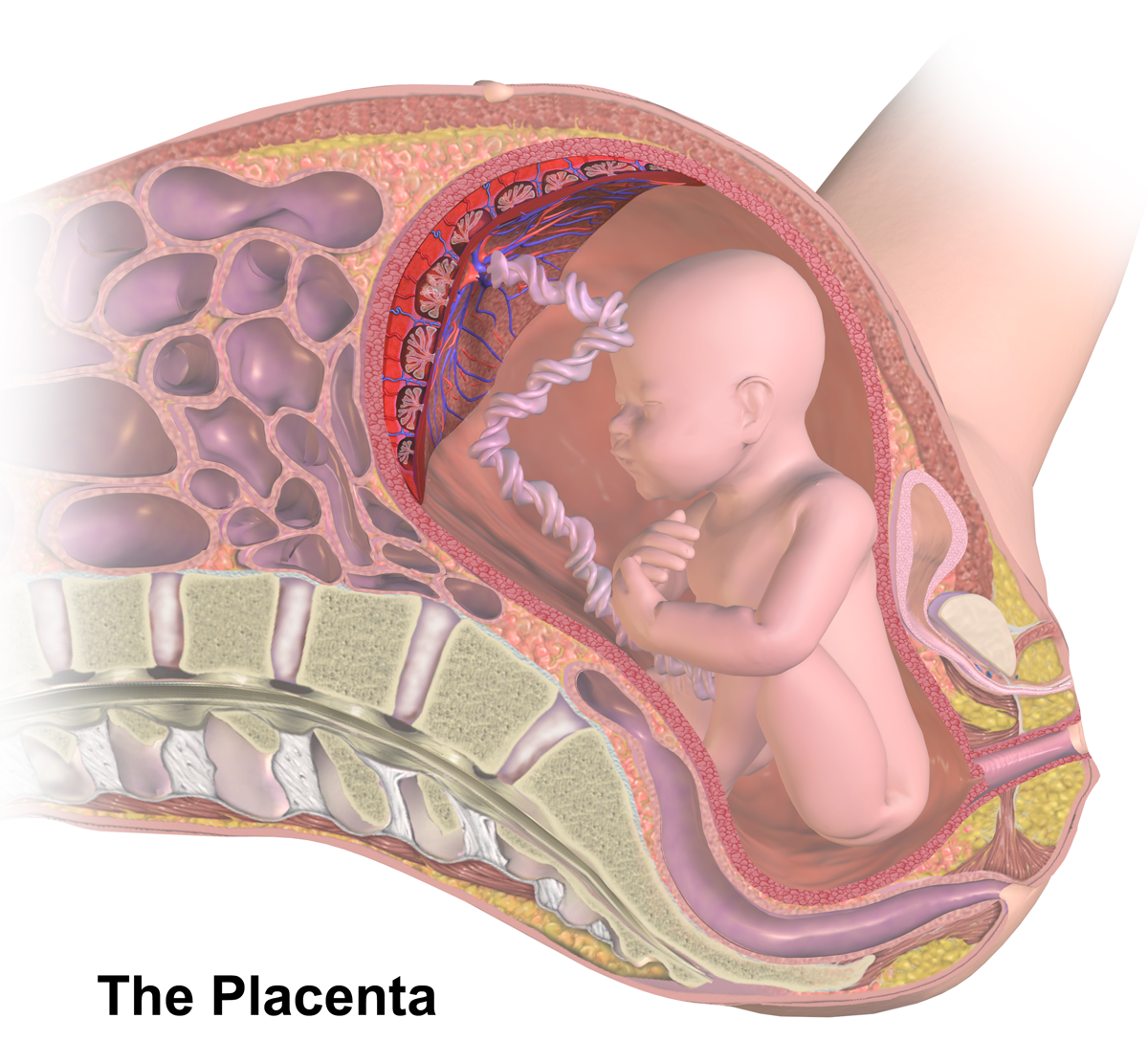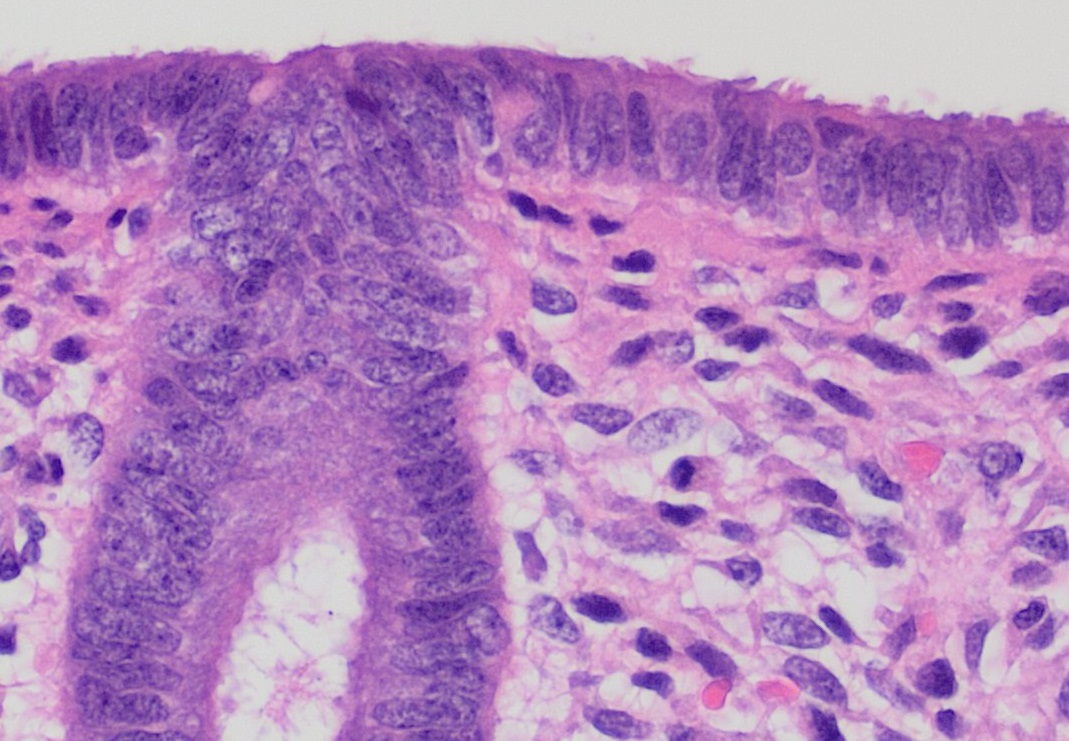|
Retained Placenta
Retained placenta is a condition in which all or part of the placenta or membranes remain in the uterus during the third stage of labour. Retained placenta can be broadly divided into: * failed separation of the placenta from the uterine lining * placenta separated from the uterine lining but retained within the uterus A retained placenta is commonly a cause of postpartum haemorrhage, both primary and secondary. Retained placenta is generally defined as a placenta that has not undergone placental expulsion within 30 minutes of the baby’s birth where the third stage of labor has been managed actively.Maternity - Prevention, Early Recognition & Management of Postpartum Haemorrhage (PPH) From Department of Health, NSW. 21-Oct-2010 Signs ...
|
Placenta
The placenta (: placentas or placentae) is a temporary embryonic and later fetal organ that begins developing from the blastocyst shortly after implantation. It plays critical roles in facilitating nutrient, gas, and waste exchange between the physically separate maternal and fetal circulations, and is an important endocrine organ, producing hormones that regulate both maternal and fetal physiology during pregnancy. The placenta connects to the fetus via the umbilical cord, and on the opposite aspect to the maternal uterus in a species-dependent manner. In humans, a thin layer of maternal decidual ( endometrial) tissue comes away with the placenta when it is expelled from the uterus following birth (sometimes incorrectly referred to as the 'maternal part' of the placenta). Placentas are a defining characteristic of placental mammals, but are also found in marsupials and some non-mammals with varying levels of development. Mammalian placentas probably first evolved abou ... [...More Info...] [...Related Items...] OR: [Wikipedia] [Google] [Baidu] [Amazon] |
Uterus
The uterus (from Latin ''uterus'', : uteri or uteruses) or womb () is the hollow organ, organ in the reproductive system of most female mammals, including humans, that accommodates the embryonic development, embryonic and prenatal development, fetal development of one or more Fertilized egg, fertilized eggs until birth. The uterus is a hormone-responsive sex organ that contains uterine gland, glands in its endometrium, lining that secrete uterine milk for embryonic nourishment. (The term ''uterus'' is also applied to analogous structures in some non-mammalian animals.) In humans, the lower end of the uterus is a narrow part known as the Uterine isthmus, isthmus that connects to the cervix, the anterior gateway leading to the vagina. The upper end, the body of the uterus, is connected to the fallopian tubes at the uterine horns; the rounded part, the fundus, is above the openings to the fallopian tubes. The connection of the uterine cavity with a fallopian tube is called the utero ... [...More Info...] [...Related Items...] OR: [Wikipedia] [Google] [Baidu] [Amazon] |
Childbirth
Childbirth, also known as labour, parturition and delivery, is the completion of pregnancy, where one or more Fetus, fetuses exits the Womb, internal environment of the mother via vaginal delivery or caesarean section and becomes a newborn to the world. In 2019, there were about 140.11 million human births globally. In Developed country, developed countries, most deliveries occur in hospitals, while in Developing country, developing countries most are home births. The most common childbirth method worldwide is vaginal delivery. It involves four stages of labour: the cervical effacement, shortening and Cervical dilation, opening of the cervix during the first stage, descent and birth of the baby during the second, the delivery of the placenta during the third, and the recovery of the mother and infant during the fourth stage, which is referred to as the Postpartum period, postpartum. The first stage is characterised by abdominal cramping or also back pain in the case of B ... [...More Info...] [...Related Items...] OR: [Wikipedia] [Google] [Baidu] [Amazon] |
Uterine Lining
The endometrium is the inner epithelial layer, along with its mucous membrane, of the mammalian uterus. It has a basal layer and a functional layer: the basal layer contains stem cells which regenerate the functional layer. The functional layer thickens and then is shed during menstruation in humans and some other mammals, including other apes, Old World monkeys, some species of bat, the elephant shrew and the Cairo spiny mouse. In most other mammals, the endometrium is reabsorbed in the estrous cycle. During pregnancy, the glands and blood vessels in the endometrium further increase in size and number. Vascular spaces fuse and become interconnected, forming the placenta, which supplies oxygen and nutrition to the embryo and fetus.Blue Histology - Female Reproductive System . Schoo ... [...More Info...] [...Related Items...] OR: [Wikipedia] [Google] [Baidu] [Amazon] |
Haemorrhage
Bleeding, hemorrhage, haemorrhage or blood loss, is blood escaping from the circulatory system from damaged blood vessels. Bleeding can occur internally, or externally either through a natural opening such as the mouth, nose, ear, urethra, vagina, or anus, or through a puncture in the skin. Hypovolemia is a massive decrease in blood volume, and death by excessive loss of blood is referred to as exsanguination. Typically, a healthy person can endure a loss of 10–15% of the total blood volume without serious medical difficulties (by comparison, blood donation typically takes 8–10% of the donor's blood volume). The stopping or controlling of bleeding is called hemostasis and is an important part of both first aid and surgery. Types * Upper head ** Intracranial hemorrhage — bleeding in the skull. ** Cerebral hemorrhage — a type of intracranial hemorrhage, bleeding within the brain tissue itself. ** Intracerebral hemorrhage — bleeding in the brain caused by the rupture of ... [...More Info...] [...Related Items...] OR: [Wikipedia] [Google] [Baidu] [Amazon] |
Placental Expulsion
Placental expulsion (also called afterbirth) occurs when the placenta comes out of the birth canal after childbirth. The time between the expulsion of the baby and the expulsion of the placenta is called the third stage of labor. The third stage of labor can be managed actively with several standard procedures, or it can be managed expectantly, with physiological management or passive management. The latter allows for the placenta to be expelled without medical assistance. Although uncommon, in some countries, such as the United States, Germany, France, Australia, and the United Kingdom, the placenta is kept and consumed by the mother over the weeks following the birth. This practice is termed human placentophagy and can be harmful. Physiology Hormone induction of placental separation As the fetal hypothalamus matures, the activation of the hypothalamic–pituitary–adrenal (HPA) axis initiates labor through two hormonal mechanisms. The end pathway of both mechanisms lead ... [...More Info...] [...Related Items...] OR: [Wikipedia] [Google] [Baidu] [Amazon] |
Ergometrine
Ergonovine, also known as ergometrine and lysergic acid propanolamide, is a medication used to cause contractions of the uterus to treat heavy vaginal bleeding after childbirth. It can be used either by mouth, by injection into a muscle, or injection into a vein. Common side effects include high blood pressure, vomiting, seizures, headache, and low blood pressure. Other serious side effects include ergotism. Ergonovine was discovered in 1932. It is on the World Health Organization's List of Essential Medicines. Ergonovine is controlled in some countries because it can be used to make the psychedelic drug lysergic acid diethylamide (LSD). It is also known to produce psychedelic effects itself at high doses. Medical uses Ergonovine has a medical use in obstetrics to facilitate delivery of the placenta and to prevent bleeding after childbirth by causing smooth muscle tissue in the blood vessel walls to narrow, thereby reducing blood flow. It is usually combined with oxyto ... [...More Info...] [...Related Items...] OR: [Wikipedia] [Google] [Baidu] [Amazon] |
Cord Traction
Cord or CORD may refer to: Common meanings * String (structure), String * Thin rope * Twine * Cord (unit) used for measuring wood * Power cord * Umbilical cord Cord or CORD may also refer to: Places * Cord, Arkansas People * Alex Cord (1933–2021), American actor and writer * Chris Cord (born 1940), American racing driver * Errett Lobban Cord (1894–1974) American industrialist * Ronnie Cord (1943–1986), Brazilian singer * Cord Jefferson, American writer and film director * Cord McCoy (born 1980), American bull and saddle bronc rider * Cord Meyer (1920–2001), American CIA official * Cord Parks (born 1986), American professional football player * Cord Phelps (born 1987), American professional baseball player * Cord Pool, guitarist for American red dirt metal band Texas Hippie Coalition * Cord Widderich (died 1447), German pirate Arts, entertainment, and media * Cord (band), a British rock group * Cord (film), ''Cord'' (film), a 2000 film starring Daryl Hannah and ... [...More Info...] [...Related Items...] OR: [Wikipedia] [Google] [Baidu] [Amazon] |
Placenta Accreta
Placenta accreta spectrum (PAS) is a medical condition that occurs when all or part of the placenta attaches abnormally to the ''myometrium'' (the muscular layer of the uterine wall) during pregnancy. This condition was first documented in medical literature in 1927. Three grades of abnormal placental attachment are defined according to the depth of attachment and invasion into the muscular layers of the uterus. From least to most invasive uterine attachment they are: ''Placenta'' ''Accreta,'' ''Increta,'' and ''Percreta.'' Because of abnormal attachment to the myometrium, PAS is associated with an increased risk of massive hemorrhaging, heavy bleeding, at the time of attempted vaginal delivery. This leads many to deliver through a caesarean section. The need for transfusion of blood products is frequent, and a surgical removal of the uterus (hysterectomy) is sometimes required to control life-threatening bleeding. Rates of placenta accreta are increasing, and are even higher in ... [...More Info...] [...Related Items...] OR: [Wikipedia] [Google] [Baidu] [Amazon] |
Fetal Membranes
The fetal membranes are the four extraembryonic membranes, associated with the developing embryo, and fetus in humans and other mammals. They are the amnion, chorion, allantois, and yolk sac. The amnion and the chorion are the chorioamniotic membranes that make up the amniotic sac which surrounds and protects the embryo. The fetal membranes are four of six accessory organs developed by the conceptus that are not part of the embryo itself, the other two are the placenta, and the umbilical cord. Structure The fetal membranes surround the developing embryo and form the fetal-maternal interface. The fetal membranes are derived from the trophoblast layer (outer layer of cells) of the implanting blastocyst. The trophoblast layer differentiates into amnion and the chorion, which then comprise the fetal membranes. The amnion is the innermost layer and, therefore, contacts the amniotic fluid, the fetus and the umbilical cord. The internal pressure of the amniotic fluid cau ... [...More Info...] [...Related Items...] OR: [Wikipedia] [Google] [Baidu] [Amazon] |
Obstetrics
Obstetrics is the field of study concentrated on pregnancy, childbirth and the postpartum period. As a medical specialty, obstetrics is combined with gynecology under the discipline known as obstetrics and gynecology (OB/GYN), which is a surgical field. Main areas Prenatal care Prenatal care is important in screening for various complications of pregnancy. This includes routine office visits with physical exams and routine lab tests along with telehealth care for women with low-risk pregnancies: Image:Ultrasound_image_of_a_fetus.jpg, 3D ultrasound of fetus (about 14 weeks gestational age) Image:Sucking his thumb and waving.jpg, Fetus at 17 weeks Image:3dultrasound 20 weeks.jpg, Fetus at 20 weeks First trimester Routine tests in the first trimester of pregnancy generally include: * Complete blood count * Blood type ** Rh-negative antenatal patients should receive RhoGAM at 28 weeks to prevent Rh disease. * Indirect Coombs test (AGT) to assess risk of hem ... [...More Info...] [...Related Items...] OR: [Wikipedia] [Google] [Baidu] [Amazon] |






